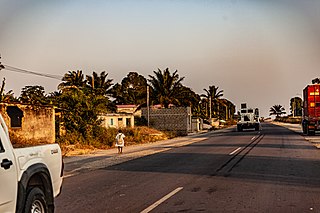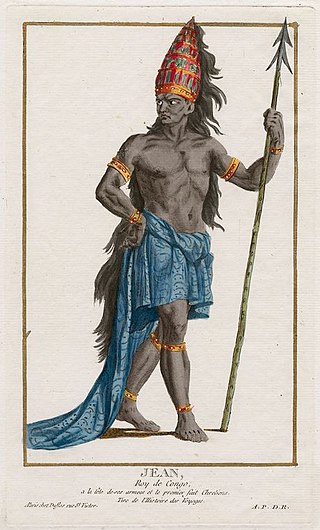
The Kingdom of Kongo was a kingdom in Central Africa. It was located in present-day northern Angola, the western portion of the Democratic Republic of the Congo, southern Gabon and the Republic of the Congo. At its greatest extent it reached from the Atlantic Ocean in the west to the Kwango River in the east, and from the Congo River in the north to the Kwanza River in the south. The kingdom consisted of several core provinces ruled by the Manikongo, the Portuguese version of the Kongo title Mwene Kongo, meaning "lord or ruler of the Kongo kingdom", but its sphere of influence extended to neighbouring kingdoms, such as Ngoyo, Kakongo, Loango, Ndongo, and Matamba, the latter two located in what is Angola today.

Kwilu, also known as the House of Kwilu, was a kanda or royal lineage of the Kingdom of Kongo.

Soyo is a city, with a population of 200,920, and a municipality, with a population of 227,175, located in the province of Zaire in Angola, at the mouth of the Congo River. Historically, Soyo was a significant city in conflicts between the Kingdom of Kongo, Portuguese Angola, and the Dutch West India Company. Soyo became an independent state in the 17th century and had significant influence on politics in Kongo during the Kongo Civil War.

Garcia II Nkanga a Lukeni a Nzenze a Ntumba, also known as Garcia Afonso for short, ruled the Kingdom of Kongo from 23 January 1641 to 1661. He is sometimes considered Kongo's greatest king for his religious piety and his near expulsion of the Portuguese from Angola. Yet, he is also notorious for enriching himself through his leading role in the Atlantic slave trade.

The Catholic Church arrived in the Kingdom of Kongo shortly after the first Portuguese explorers reached its shores in 1483. The Portuguese left several of their own number and kidnapped a group of Kongo including at least one nobleman, Kala ka Mfusu, taking them to Portugal where they stayed a year, learned Portuguese and were converted to Christianity. The group was returned to Kongo in 1485 and Kala ka Mfusu led a royal mission from Kongo's manikongo, Nzinga a Nkuwu to Portugal. Following their arrival in late 1486 the embassy stayed nearly four years in Lisbon with the monks of Saint John the Baptist. There they studied Christianity and Portuguese with Vicente dos Anjos, and began the start of a Kongolese version of Christianity.

The Kinlaza were members of the Nlaza kanda or House of Kinlaza, one of the ruling houses of the Kingdom of Kongo during the 17th century. It was one of the main factions during the Kongo Civil War along with the Kimpanzu and Kinkanga a Mvika kandas. They are remembered in tradition and are evoked in a proverb, still current in the 1920s Nkutama a mvila za makanda "Kinkanga, Kimpanzu ye Kinlaza makukwa matatu malambila Kongo".

Nkumbi-a-Mpudi Diogo I was manikongo in 1545–1561. King Diogo was the grandson of king Afonso I of Kongo and won the throne after overthrowing his uncle Pedro Nkanga a Mvemba and forcing him to take refuge in a church in São Salvador. Diogo's early struggles are documented in a legal inquest he conducted in 1550 into a plot against him launched by the former king. In 1555, the king cut all ties with the Portuguese whom he saw as meddlesome and a threat to the kingdom and expelled all 70 Portuguese inhabitants from the kingdom.

Mvemba a Nzinga, Nzinga Mbemba, Funsu Nzinga Mvemba or Dom Alfonso, also known as King Afonso I, was the sixth ruler of the Kingdom of Kongo from the Lukeni kanda dynasty and ruled in the first half of the 16th century. He reigned over the Kongo Empire from 1509 to late 1542 or 1543.

Lukeni lua Nimi was the traditional founder of the Lukeni kanda dynasty, first king of Kongo and founder of the Kingdom of Kongo Dia Ntotila. The name Nimi a Lukeni appeared in later oral traditions and some modern historians, notably Jean Cuvelier, popularized it. He conquered the kingdom of Mwene.

King João I was the 5th ManiKongo of the Kingdom of Kongo between 1470 and 1509. He voluntarily converted to Roman Catholicism. He was baptized on 3 May 1491 and took the Christian name of João. Soon after, ManiKongo Nzinga-a-Nkuwu João I abandoned the new faith for a number of reasons, one of them being the Roman Catholic Church's requirement of monogamy. Politically, he could not afford to abandon polygamy and embrace monogamy, a cultural shift that the king could not contemplate as power in Kongo was elective, rather than hereditary as in Europe; as Kongo culture followed a matrilineality structure, where the elder son of the king is not automatically the next king.
Afonso III Mvemba a Nimi was a ruler of the kingdom of Kongo during its civil war period.
Afonso II was a ruler of the Kingdom of Kongo in 1561.
The Kongo Civil War (1665–1709) was a war of succession between rival houses of the Kingdom of Kongo. The war waged throughout the middle of the 17th and 18th centuries pitting partisans of the House of Kinlaza against the House of Kimpanzu. Numerous other factions entered the fray claiming descent from one or both of the main parties such as the Água Rosada of Kibangu and the da Silva of Soyo. By the end of the war, Kongo's vaunted capital had been destroyed and many Bakongo were sold into the Trans-Atlantic Slave Trade.
Ambrósio I Nimi a Nkanga was a mwenekongo of the Kingdom of Kongo who ruled from

Garcia I Mvemba a Nkanga was a manikongo of Kongo who ruled from April 27, 1624 to March 7, 1626.

Mbanza Kongo, is the capital of Angola's northwestern Zaire Province with a population of 148,000 in 2014. Mbanza Kongo was the capital of the Kingdom of Kongo since its foundation before the arrival of the Portuguese in 1483 until the abolition of the kingdom in 1915, aside from a brief period of abandonment during civil wars in the 17th century. In 2017, Mbanza Kongo was declared a UNESCO World Heritage Site.
Álvaro X Nimi a Mvemba Água Rosada was a ruler of Kibangu and was the first Água Rosada claimant to the throne of the Kingdom of Kongo during its civil war. He ruled the Kingdom of Kibangu from 1688 to 1695.

Angolan nationality law is regulated by the Constitution of Angola, as amended; the Nationality Act, and its revisions; and various international agreements to which the country is a signatory. These laws determine who is, or is eligible to be, a national of Angola. The legal means to acquire nationality, formal legal membership in a nation, differ from the domestic relationship of rights and obligations between a national and the nation, known as citizenship. Angolan nationality is typically obtained under the principle of jus sanguinis, i.e. by birth in Angola or abroad to parents with Angolan nationality. It can be granted to persons with an affiliation to the country, or to a permanent resident who has lived in the country for a given period of time through naturalization.
Ana Afonso de Leão was the queen regnant of the Kingdom of Nkondo between 1673 and 1710. She conquered the territories of Lemba and Matari, as well as those located along the Mbidizi river in the Kingdom of Kongo in the 17th century. She was a decisive figure during the Kongolese civil war.













